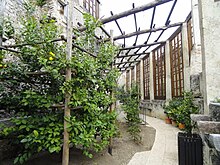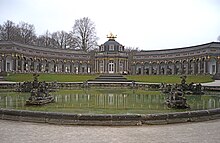Orangery

An orangery is a historical representative garden for citrus plants . While orangery (also limonaia ) was a synonym for “collection of exotic, not winter-proof plants” in the 17th and 18th centuries, the term has been transferred to the buildings in which the collections were housed since the 18th century. Orangeries were particularly common in the context of representative baroque palace and gardens .
development
From the 16th century collections of orange and other citrus trees came into fashion at European royal courts, and sometimes also of pomegranate , fig , laurel , pistachio and olive trees . Such a tree population was obviously called the orangery , so the term only applied to the trees.


Initially, the trees were rooted in the ground like an arboretum and were built over with wooden crates in winter, the so-called "cut-off greenhouses". The earliest can be traced back to 1549 in Vienna's Burggarten; in the following years similar ones were created in Heidelberg, Stuttgart and Prague. The fig House of Prague Castle from Ulrico Aostalli had fixed rear and side walls with degradable roof. Such constructions are still used in Limone sul Garda today.
With the introduction of the planter, however, the trees became mobile. The technical breakthrough came with the invention of the bucket transport wagon by André Le Nôtre (1613–1700), the gardener of Versailles Palace . In the second half of the 17th century permanent orangery buildings were built, which were heated with tiled stoves, and later also glass houses. According to Dezallier d'Argenville , so that the bitter oranges did not die in winter, they were dependent on winter gardens: for northern countries such as Holland, Sweden, but also England, he even recommended greenhouses for the summer months . Orangeries were only used for decorative and representational purposes on a subordinate scale. Initially, they were there to house the citrus trees and other frost-sensitive plants in the winter months. They were huddled together in a small space (French serrer ), from which the original name for orangeries ( Serre ) was derived.
Three classic ways of setting up the orangery in the open air developed: the square , in which the citrus trees were placed in a rectangular shape , the circle and the theater shape. In the latter arrangement, the most elaborate, the trees were positioned in a semicircle.
Orangeries were used for ornamental and representational purposes as well as to satisfy the royal courts' increasing need for exotic and especially citrus fruits . The citrus tree was excellently suited as a representative object because, on the one hand, various mythological connections could be made with it and, on the other hand, it was widely traveled and therefore very expensive.
symbolism

The orangery cult of modern times goes back to Classical Roman antiquity: Alexander the Great introduced the citron as an ornamental and medicinal plant from Persia and Roman writers of the Augustan period (such as Virgil in his Eclogae , Horace in his Epodes and Ovid in his Metamorphoses ) had used them as a symbol for the golden apples of the Hesperides (hence the initially common name as "Hesperides Gardens"), for the virtues of Hercules and, above all, for eternal life and eternal return , as the metamorphoses are supposed to make clear - and thus above all as an allegory for the alleged return of the Golden Age under Augustus .
So return: In his Aeneid , Virgil lets the Trojan prince Aeneas flee to Latium , just like Saturn , who had been disempowered by his son Jupiter ; there the refugee takes control and helps the people of Rome and the surrounding area to a regional golden age; therefore citrus fruits also stood for Rome's claim to eternity, on which the Holy Roman Empire was linked. The idea of the “second coming” was known not only in the ancient Stoa as apokatastasis , but also in Christian theology as parousia . The Renaissance humanism led through the intense study of ancient writers to resume the ancient Neo-Platonism and ancient to revive allegories, which then also frequently appear in the imagery of orangeries. The ambitious Baroque princes liked the idea of a return to the Golden Age. The evergreen citrus trees, bearing fruit and blossoms at the same time, became the most popular plants in the architectural gardens of the Renaissance and Baroque because of their symbolic content and their scent.
The orangery building
In particular, the firmly rooted orangeries required a winter garden right next to the plantation , in which the trees dug up with the entire rootstock could winter. Such orangery buildings were soon referred to as orangery themselves, and in today's parlance this word usage is almost the only one.
Although the later potted plants no longer needed a wintering building located directly next to the installation site and this was therefore mostly at a distance, orangery buildings were still built. In many cases, these no longer served horticultural purposes but rather purely representative purposes and the pleasure of the princely rulers. Such orangery buildings could therefore also be pure prospect architecture, giving the artfully placed citrus trees a worthy frame and in which painting exhibitions, banquets and similar merrymaking were held. For this purpose, the orangery buildings are often built as a round (or two semicircles) or semicircles, so that the orangery could be set up in a circle or tearo shape in the courtyard they designated. The windows that reach down to the floor are a key architectural feature. A typical feature of the architectural type orangery building is, due to the representative function, the use of princely forms of dignity such as the motif of the triumphal arch. The orangery and thus the orangery building could be erected both in connection with the ornamental garden of the entire palace complex (as is the case with most of the palace complexes) and set up autonomously. The architectural reference to the vegetable garden of the palace, as in Palace of Versailles , is still indicative of the original gardening function of the orangery .
The end of the orangeries
Increasingly, not only citrus trees but also other exotic plants were kept for representation or ornamentation, for example pineapples and figs . At the end of the 18th century (later in Germany) orange cultivation went out of fashion and the horticultural function of the orangery buildings was transferred to the palm houses of the 19th century. Since the modern monument protection of the orangery as a separate garden design type is paying increasing attention, many former orangeries have meanwhile been restored or rebuilt.
List of Central European Orangeries


- Germany
- Orangery in Altenburg
- Orangery in Altdöbern Castle Park
- Orangery in Altshausen Castle
- Orangery in Ansbach
- Orangery in the spa gardens in Bad Homburg vor der Höhe
- Orangery in Bad Muskau
- Orangery in the Hermitage , Bayreuth
- Orangery in Bendeleben
- Great Orangery Charlottenburg Palace , Berlin
- Small orangery in Charlottenburg Palace , Berlin
- Former orangery house , Berlin-Mitte
- Orangery in Biendorf Castle
- Orangery in Blieskastel
- Orangery of Börln Castle
- Orangery of the Bronnbach Monastery
- Orangery in Darmstadt-Bessungen
- Luisium Orangery in Dessau
- Zwinger in Dresden
- Orangery in the Benrath Palace Park in Düsseldorf
- Orangery in Dyck Castle
- Orangery in Ellingen
- Orangery in Erbach Castle (Odenwald)
- Orangery in Erlangen
- Orangery in the Grugapark in Essen
- Orangery at Eutin Castle
- Orangery of the Fulda City Palace
- Orangery in Gera
- Orangery at Glücksburg Castle
- Orangery in Gotha
- Orangery in Großsedlitz
- Orangery in Philippsruhe Castle in Hanau
- Orangery in the Great Garden in Hanover-Herrenhausen
- Orangery in the Handschuhsheimer Schlösschen in Heidelberg
- Orangery in Herten Castle
- Reconstructed orangery of Ismaning Castle
- Orangery in Karlsruhe
- Orangery in the Karlsaue , Kassel
- Orangery in Cologne
- Orangery in Meuselwitz
- Orangery of the Haydau monastery in Morschen - Altmorschen
- Orangery of the Ludwigsburg residential palace in Ludwigsburg
- Orangery in Mosigkau Castle
- Orangery in the Botanical Garden of Münster
- Orangery in Neustrelitz
- Orangery in Neuzelle Monastery
- Orangery in Nordkirchen Castle
- Oranienbaum Castle , the longest of all German orangeries
- Orangery in Pillnitz Castle
- Orangery Palace in Potsdam
- Marstall (former Pomeranzenhaus) of the Potsdam City Palace
- Orangery in Putbus
- Former orangery at Schloss Wollening in Regensburg
- Orangery in Rheda-Wiedenbrück
- Orangery in Saalburg-Ebersdorf / Thuringia
- Orangery in Salzdahlum Castle
- Orangery of Schwerin Castle
- Orangery in Sondershausen Castle
- Orangery in Schwetzingen
- Orangery in the Zehnhof Sinzig
- Orangery in the Stuttgart Palace Gardens
- Orangery in Wallerfangen
- Upper and lower orangery of Weilburg Castle
- Orangery in the Belvedere Palace in Weimar
- Orangery in Weikersheim Castle
- Orangery and palm house in the pleasure garden in Wernigerode
- Orangery of the Würzburg Residence
- Bitter orange garden (Leonberg)
- Austria
- Orangery of Schönbrunn Palace , Vienna
- Orangery at the Lower Belvedere , Vienna
- Orangery in Hof Palace , Lower Austria
- Orangery in the Rosarium Baden , Lower Austria
- Fig house of the Kremsmünster Abbey
- Orangery in Hellbrunn Palace , Salzburg
- Orangery in Mirabell Palace , Salzburg
- Orangery in Schärding
- Orangery in Stams Abbey , Tyrol
- Orangery in Zwettl Abbey , Lower Austria
- Switzerland
- Orangery Elfenau in Bern
- Other countries
- Orangery in Leuven , Belgium
- Orangery in Laeken , Belgium
- Parc de l'Orangerie in Strasbourg , France
- Orangery in Echternach , Luxembourg
- Orangery in the Lower Silesian monastery Heinrichau , Poland
- Orangery in Lednice Castle , Czech Republic
- Orangeries used today as showrooms
- City library in the orangery in Kempten , Germany
- Draenert Orangery on Lake Constance, Germany
- Orangery in Belvedere Palace in Vienna , Austria
- Orangerie d'Or in Graz, Austria
- Musee de l'Orangerie in Paris , France
Orangery in Düsseldorf-Benrath
Remains of the orangery on the Karlsberg near Homburg, destroyed in 1793
Orangery in Bad Muskau
Individual evidence
- ↑ Reinhard Wegner: Art - the other nature (aesthetics around 1800), Vandenhoeck & Ruprecht 2004, p. 101 ( online )
- ↑ The name still lives on in the Nuremberg Hesperides Gardens.
- ^ Helmut-Eberhard Paulus , Orangery Dreams in Thuringia . Schnell & Steiner, Regensburg 2005, ISBN 978-3795417895
- ↑ https://www.ahgz.de/regional-und-lokal/bad-homburg-neue-paechter-in-der-kurpark-orangerie,200012175382.html
- ^ Homepage of the city of Herten .
literature
- Simone Balsam (Red.): Golden oranges, laurel and palm trees - orangery culture from the 16th to 19th centuries. Festschrift for Heinrich Hamann . (Series of publications by the Orangeries in Germany Working Group; Vol. 6). Imhof, Petersberg 2010, ISBN 978-3-86568-226-0
- Simone Balsam (Red.): Orangeries in Europe. Of princely wealth and horticultural art . Lipp, Munich 2007, ISBN 3-87490-683-3
- Judith Breuer : Orangeries in the Main-Tauber district. Examples in Bronnbach, Eichel, Messelhausen, Weikersheim and Wertheim. In: Monument Preservation in Baden-Württemberg , 35th year 2006, issue 3, pp. 120–128 ( PDF )
- Marcus Köhler (Ed.): Orangeries. Glass houses, greenhouses, winter gardens in Mecklenburg-Western Pomerania . Aland, Berlin 2003, ISBN 3-936402-05-1
- Jürgen Landwehr (Ed.): Nature behind glass. On the cultural history of orangeries and greenhouses . Contributions to the annual conference of the Gamburger Forum for Cultural Research in the Bronnbach Monastery in September 2002. Röhrig, St. Ingbert 2003, ISBN 3-86110-347-8
- Helmut-Eberhard Paulus : The golden age in the garden. Orangery as a staged allegory . In: Die Gartenkunst 23 (2/2011), pp. 195–204.
- Helmut-Eberhard Paulus: Orangery dreams in Thuringia. Orangery of the Thuringian Palaces and Gardens Foundation . Edited by the Thuringian Palaces and Gardens Foundation. Schnell and Steiner, Regensburg 2005, ISBN 3-7954-1789-9
Web links
- Contribution to the history of the orangeries at Monumente Online
- www.orangeriekultur.de Website of the Orangeries in Germany working group













